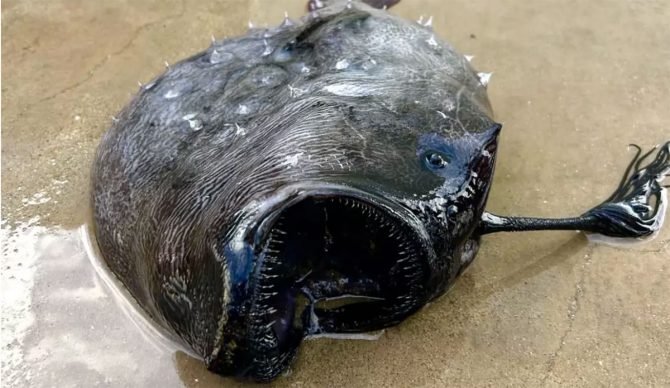
The rare anglerfish washed ashore at Crystal Cove Beach on Friday the 13th. Photo: California State Parks
There are some truly bizarre creatures swimming around down there in the deep ocean. One of the strangest by far is the anglerfish, also known as the Pacific Football fish. As they call the deep sea home, they generally aren’t found on beaches, but on Friday, October 13th, one washed up at Crystal Cove State Park in California.
Located between Corona del Mar and Laguna Beach, Crystal Cove is a staggeringly pretty place. It’s one of the rarest environments in North America, hosting a coastal sage-scrub plant community that’s extremely scarce.
It’s #WildlifeWednesday, and we’ve got a surprise guest: the Pacific Football Fish at @CrystalCoveSP, the same species of angler fish first appeared in May 2021. Two years later the same species of fish has washed up again last Friday, October 13th. pic.twitter.com/DhffTYXp92
— CA State Parks (@CAStateParks) October 18, 2023
The anglerfish that washed ashore there was a female, boasting a distinctive stalk dangling off the top of its head, which is where its name comes from. The end of the stalk features a tiny little organ called the esca, which holds bioluminescent bacteria that lights up in the inky depths to attract the anglerfish’s prey. The females grow much larger than the males, getting up to 24 inches long. This one wasn’t quite that big, however, only coming in at 14 inches. The males are tiny in comparison, growing to about an inch.
Strangely, this isn’t the first time an anglerfish has landed on the beach at Crystal Cove. Another one was found in the sand in 2021. Now it calls the Natural History Museum of Los Angeles home. The latest specimen has been collected by the California Department of Fish and Wildlife. It’s a good find for researchers, since we don’t know as much as we’d like about the elusive fish.
“There are only approximately 30 or so specimens that have been collected of this species globally,” Michelle Horeczko, a senior environmental scientist supervisor with the Department of Fish and Wildlife, told the LA Times, “which makes this find valuable and may add to what is known about their life history.”

